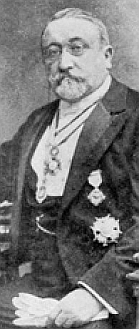Josep Domènech i Estapà facts for kids
Josep Domènech i Estapà (born in Tarragona in 1858, died in Cabrera de Mar in 1917) was a famous architect from Catalonia, a region in Spain. He designed many important buildings.
He finished his architecture studies in 1881. Later, he became a professor at the University of Barcelona, teaching subjects like geodesy (which is about measuring the Earth) and descriptive geometry (a way to draw 3D objects on a 2D surface). He also joined the Acadèmia de Ciències i Arts in 1883 and became its president in 1914.
Contents
Buildings He Designed
Josep Domènech i Estapà designed many well-known buildings, mostly in Barcelona. Here are some of his most famous projects:
Important Buildings in Barcelona
- Palace of Justice (Palau de la Justícia) (1887-1908): This large courthouse was built with another architect, Enric Sagnier i Villavecchia. It's a very grand building.
- Palau Montaner (1889-1896): He worked on this building with Lluís Domènech i Montaner. Today, it is used by the Spanish Government in Barcelona.
- University of Barcelona's Faculty of Medicine (1904): This is where students learn to become doctors.
- Modelo Prison (1904): He designed this prison with Salvador Vinyals i Sabaté.
- CosmoCaixa Barcelona (1904-1909): Originally, this building was a home for blind people. Now, it's a popular science museum called CosmoCaixa Barcelona.
- Fabra Observatory (1906): This observatory is located on a mountain and is used to study stars and planets.
- Catalana de Gas i Electricitat building and water tower (1908): He designed the main building and a tall water tower for this gas and electricity company.
- Church of Our Lady of Carmen (1910-1921): This church and its convent were finished by his son after Josep's death.
- Magoria Station (1912): This was a railway station he designed.
He also helped build the Hospital Clínic de Barcelona (1895-1906), which is a large hospital. In the town of Viladrau, he designed the Hotel Bofill in 1898.
His Architectural Style
Josep Domènech i Estapà had his own special way of designing buildings. He took ideas from classic architectural styles and changed them to create something new. His style was different from both Eclecticism (mixing many styles) and Modernisme (a popular art movement in Catalonia at the time). Even though his style was unique, it was well-liked by important people and organizations.
He also wrote several books about architecture, including Tratado de geometría descriptiva and El modernismo arquitectónico (1911).
Gallery
-
Fabra Observatory on Collserola, Barcelona
-
Palau de la Justícia - Palace of Justice in Barcelona, built together with Enric Sagnier i Villavecchia.
-
Reial Acadèmia de Ciències i Arts - Royal Academy of Sciences and Arts / Teatre Poliorama, Barcelona, Rambles.
See also
 In Spanish: José Doménech Estapá para niños
In Spanish: José Doménech Estapá para niños













